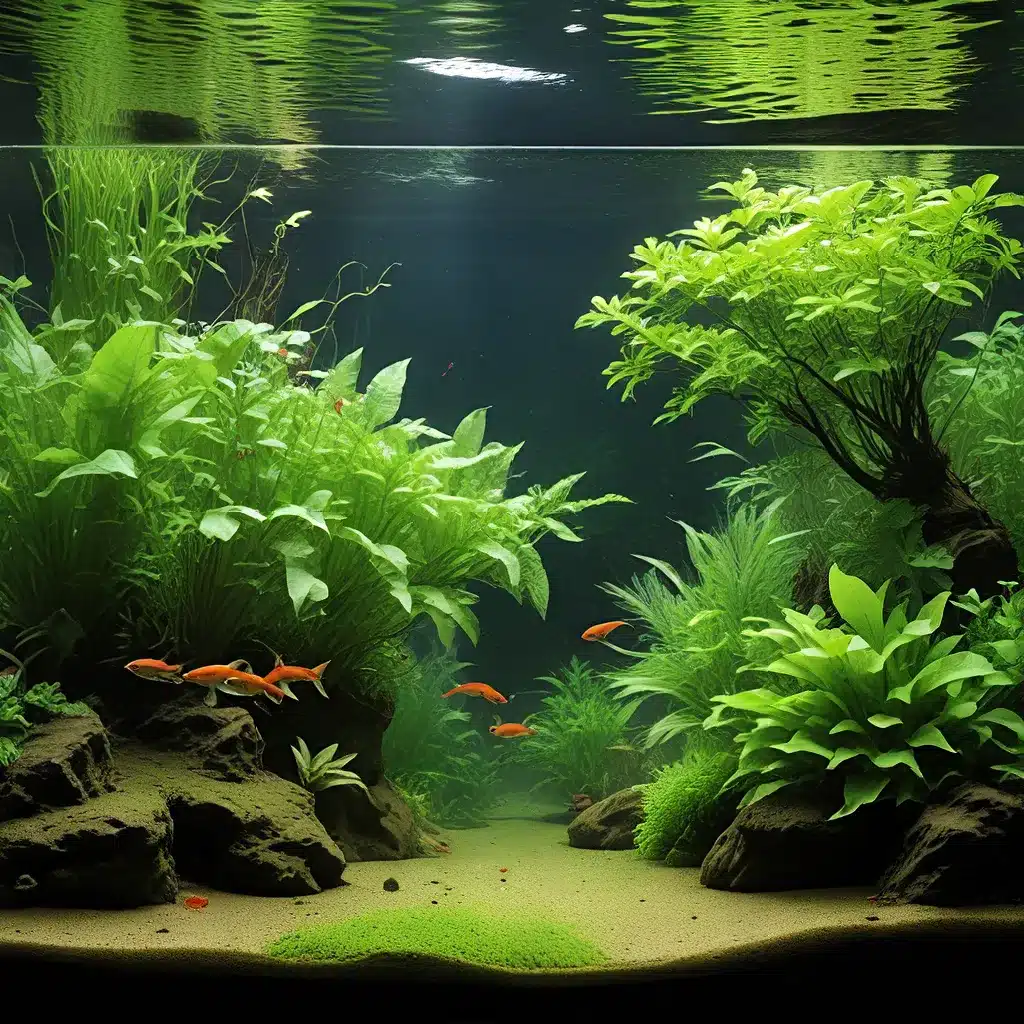
Unlocking the Secrets of Aquatic Plant Care
Aquatic plants are the unsung heroes of the aquarium world. These vibrant, living elements not only enhance the aesthetic appeal of your underwater oasis but also play a crucial role in maintaining a healthy, balanced ecosystem for your finned inhabitants. As the foundation of a thriving aquarium, understanding the intricacies of aquatic plant care is the key to creating a captivating and self-sustaining habitat.
One of the primary benefits of incorporating aquatic plants into your aquarium is their ability to purify the water. Through a process known as photosynthesis, these submerged botanicals absorb carbon dioxide and release oxygen, helping to maintain optimal dissolved oxygen levels for your fish. Additionally, aquatic plants act as natural filtration systems, effectively removing excess nutrients, such as nitrates and phosphates, that can otherwise lead to water quality issues and algae blooms.
Choosing the Right Aquatic Plants for Your Aquarium
When it comes to selecting the appropriate aquatic plants for your aquarium, there are a few key factors to consider. Plant size, growth habits, and light requirements are all crucial elements in creating a harmonious underwater landscape. For example, foreground plants like dwarf hairgrass or Eleocharis acicularis thrive in low-light conditions and have a compact, carpeting growth pattern, making them ideal for the front of your aquarium. In contrast, tall, bushy plants like Cryptocoryne wendtii or Anubias barteri are better suited for the middle or background, providing depth and visual interest.
| Plant Type | Light Requirements | Growth Habits |
|---|---|---|
| Dwarf Hairgrass (_Eleocharis acicularis_) | Low to Medium | Compact, carpeting growth |
| Cryptocoryne wendtii | Medium to High | Tall, bushy growth |
| Anubias barteri | Low to Medium | Tall, broad leaves |
It’s important to note that the specific lighting requirements for your aquatic plants will also depend on the overall lighting setup in your aquarium. Ensuring that your plants receive the appropriate amount of illumination is crucial for their health and growth.
Mastering the Art of Aquascaping
Aquascaping, the intricate art of arranging aquatic plants and hardscape elements to create visually stunning underwater landscapes, is a captivating aspect of the aquarium hobby. By thoughtfully designing the layout and composition of your aquarium, you can transform a simple glass box into a mesmerizing underwater oasis.
One of the key principles of successful aquascaping is the use of the Golden Ratio, a mathematical concept that aims to create a harmonious and aesthetically pleasing arrangement. By applying this principle to the placement of plants, rocks, and driftwood, you can achieve a sense of balance and depth within your aquarium.
Another important aspect of aquascaping is the incorporation of various textures and plant heights. Combining tall, bushy plants with shorter, carpeting species, and interspersing them with unique hardscape elements, can create a visually captivating and three-dimensional underwater scene.
King Aquarium offers a wealth of resources and inspiration for aquarists looking to explore the art of aquascaping. From step-by-step guides to stunning aquarium layouts, their website is a valuable resource for hobbyists seeking to elevate their aquarium design and create a true underwater masterpiece.
Maintaining a Thriving Aquatic Plant Community
Keeping aquatic plants healthy and thriving requires a delicate balance of water parameters, nutrient supplementation, and maintenance routines. Consistent water testing and adjustments, along with regular pruning and cleaning, are essential for the long-term success of your aquatic plant community.
One of the most crucial aspects of aquatic plant care is ensuring the proper nutrient balance in your aquarium. While some plants may thrive with just the nutrients present in the water, others may require additional supplementation, such as specialized plant fertilizers or liquid supplements. Monitoring the levels of essential nutrients, like nitrogen, phosphorus, and potassium, can help you identify and address any deficiencies or imbalances.
Regular water changes and vacuuming are also important for maintaining healthy aquatic plants. By removing accumulated debris and replenishing the water with fresh, dechlorinated water, you can help prevent the buildup of harmful substances and ensure that your plants receive the necessary oxygen and nutrients.
Additionally, pruning and trimming your aquatic plants on a regular basis can encourage healthy growth, prevent overcrowding, and maintain the desired aesthetic of your aquarium. Removing dead or dying leaves and selectively trimming back overgrown plants can help promote new growth and keep your underwater landscape looking its best.
Harnessing the Power of Aquatic Plants for Thriving Fish
By incorporating a diverse and well-maintained aquatic plant community into your aquarium, you can create a self-sustaining ecosystem that not only looks stunning but also provides myriad benefits for your fish. Aquatic plants serve as a natural food source, offer hiding and breeding spots, and help regulate water parameters – all of which contribute to the overall health and well-being of your finned companions.
As you embark on your aquarium journey, remember that aquatic plants are the unsung heroes of the underwater world. By mastering the art of aquatic plant care and aquascaping, you can unlock a realm of captivating beauty and balanced ecosystem management, ensuring a thriving and vibrant aquarium for years to come.

